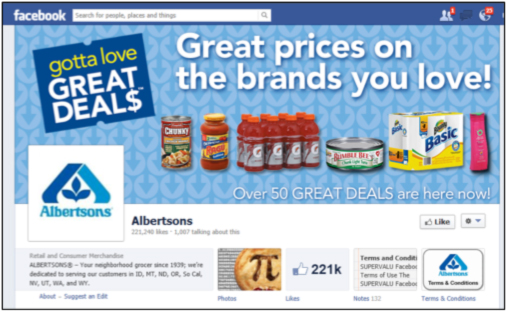Grocery Stores Get Social
In grocery store marketing, the traditional route to driving store traffic and sales has been aggressive advertising in local newspapers, plus saturation direct mail to residential addresses in the trading area around the physical store. (Saturation mail means that the mail is addressed to “resident,” or otherwise doesn’t use the name of the individual householder.) Larger chains might do a bit of broadcast media, like television and radio, to reach shoppers. But times are changing.
First, printed newspapers are in decline, and not able to cover the market the way they did in years past. And second, consumers are using new media, like social networks, blogs and other Internet channels, so grocery store marketers need to adapt to reach their customers and prospects.
The result is a huge change in how grocery stores plan to spend their ad media budgets. According to a study from Valassis, a national producer of newspaper advertising insert media, from July 2012, investments are moving directly from print to social media, combined by a small decline in broadcast media.
Chart: Expected Media Use by Grocery Retail Executives
| Medium | Currently using | Use expected 5 years from now |
| 75% | 17% | |
| Social Internet | 12% | 65% |
| Broadcast | 7% | 3% |
Source: “Supermarket Media Usage Study,” Valassis, July 2012.
Grocery marketers still appear to be uncertain about how to apply social media. According to the same Valassis study, they were very clear that broadcast is the best way to acquire new customers (45% so stated), and that print advertising is best for driving traffic and sales (46%). But when it came to Internet media (both social and display), they were applying it equally to customer acquisition, customer retention and driving traffic/sales. No doubt Internet media are still viewed as a source of experimentation for grocery marketers.
BeaconUnited, a consortium of food brokers, also studied grocery chain social media use and found some surprising results. First, they identified some early adopters of social media among grocery chains by looking at Klout, the online scoring tool that measures social influence. The top grocery chain score was attributed to Whole Foods, at 86—a mere 11 points lower than teen singing idol Justin Bieber. Publix came in at 53, and Kroger at 49. No other chain was even close.
BeaconUnited drew several useful conclusions about the benefit to grocery chains, where social media usage allows chains to:
- Identify emerging trends before their competitors. As an example, Peapod.com, the online grocery ordering site, realized they should launch grocery shopping kiosks at commuter train stations. Workers can place a shopping order on their way to work, and expect the bags of groceries to be waiting on their doorsteps when they get home that evening.
- Better measure the results of sales promotions. By counting mentions and retweets, stores can keep an eye on viral pass-along of their BOGO (buy one, get one free) offers, for example.
- Solve customer service problems early. Bad news travels fast through social media, and goes more broadly than ever before. So early detection, and aggressive remedial action, can avoid expensive problems.
- Learn more about customers and their needs. Looking at product reviews and social media product comments gives chains insights into how to buy and merchandise their product lines more effectively.
- Keep an eye on the whys behind individual store performance. Social media can serve as a valuable tool for monitoring how well store managers are handling problems, in real time.
- Measure the results of product introductions and sampling programs at the national and state level, to ensure that ordering and inventory levels keep up with demand.
For pure marketing outreach, social media offer an ideal way to distribute promotions and special offers. The recipients—likers and followers—are already aware of the store, and very likely to be current customers. Since the number one reason consumers give for connecting to a store or a brand through social media is to receive discounts and promotions, this has proven to be an essential social media marketing strategy for brands and retailers.
Albertson’s, a national chain with 221,000 followers on Facebook, goes in this direction, with its banner graphic proclaiming “gotta love GREAT DEALS.” But Whole Foods goes the other direction, using its Facebook page to deliver recipes, hosting tips, and cross-promoting its presence on other social media, like Pinterest, to its 1.1 million likers. While grocery chains are still figuring out how to get the most benefit out of social media, it’s clear that these channels will be a big part of their marketing strategies over time.



